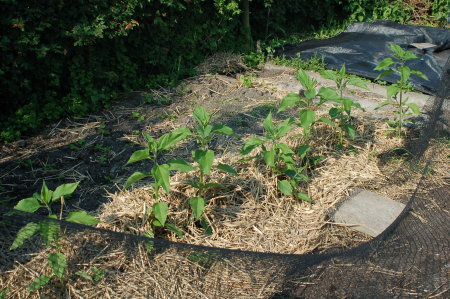
Several people have been posting pictures of Jerusalem artichokes they’ve planted recently. Here are mine, 8 plants.
For all the complaining I might do about the messes the previous gardener left behind for me (and there were a lot of them), this will surely be an issue for the next gardener. Oh well, one gardener’s dinner is another gardeners weeds.


They are growing big. I’m still waiting for mine to show…
Me too! I’m finding these as a weed in my new community garden and I’m transplanting them to my home yard for the flowers. I’ll have to join in and post my photos. They are all over the place at our community garden! Do you eat them?
Hi Kathy,
They are really a very invasive weed. While I have never planted them into the garden before, I have grown them in a pot and they produce a very elaborate root system. If you leave any pieces of root in the ground after digging them up they will re-establish themselves. I would consider it very carefully before planting them in your yard!
The flowers are not really all that spectacular. They are related to the sunflower, and look something like them, but the flowers are very tiny. They grow very tall and the size of the flower on top when compared with the rest of the plant is almost absurd.
I think they taste really nice, but only as a treat once or twice a year. They are sometimes called the windy vegetable, because they both grow large tops and so can be a wind block in your garden, and because they give you gas if you eat too many. They are very sweet, and the sugar in them is called inulin. It is very good for diabetics, but is what gives you gas.
The Dutch word for potato is ‘aardappel’ or translated means ‘apple that grows in the ground’. The Dutch word for Jerusalem artichoke is ‘aardpeer’ or ‘pear that grows in the ground’.
My favorite way of eating them is rubbed with a little olive oil and roasted in the oven. They can also be made into soup or sliced and fried like potato chips.